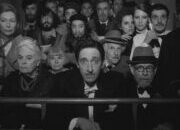
The French Dispatch is Wes Anderson’s tribute to print journalism and in particular a close nod to the stellar New Yorker magazine. A fantastic carousel of work, set in late 1960’s France and Kansas, with a star-studded cast including Bill Murray, Tilda Swinton, Owen Wilson, Benicio Del Toro, Adrien Brody, Timothee Chalamet, Jeffrey Wright and many more. They take us on a hilarious journey of mind-boggling detail, puns and name drops, together with amazing cinematography, back in time to when print journalists had large budgets, creative freedom and wide circulations. Journalistic integrity and neutrality were then necessary attributes on a distant horizon.
 The French Dispatch is the magazine supplement of a fictional Kansas newspaper – a guide to the sophisticated French way of life the whole world obsessed about back in the late 1960s. The magazine is produced by an eccentric bunch of American ex-pats living in the fictitious French town of Ennui-sur-Blasé, (the outdoor scenes actually shot in the French town of Angouleme). Like the New Yorker, the magazine has a heavy emphasis on the long read, signature cartoons, distinctive typography, and metropolitan living.
The French Dispatch is the magazine supplement of a fictional Kansas newspaper – a guide to the sophisticated French way of life the whole world obsessed about back in the late 1960s. The magazine is produced by an eccentric bunch of American ex-pats living in the fictitious French town of Ennui-sur-Blasé, (the outdoor scenes actually shot in the French town of Angouleme). Like the New Yorker, the magazine has a heavy emphasis on the long read, signature cartoons, distinctive typography, and metropolitan living.
The film is split into a few segments, each about a different section of the newspaper. Bill Murray plays the firm, yet fair, proprietor and editor, Arthur Howitzer Jnr. He has a ‘No Crying’ sign in his office and his mantra is “However you go about it, try and make it sound as though you wrote it that way on purpose.” A good strategy for life in general. When he dies, his will stipulates that the magazine sadly must end, and the first and last sections of the film cover his obituary.
Next we get to the travel column. Herbsaint Sazerac (Owen Wilson) gives us an animated cycling tour of Ennui, showing its past, present and future, highlighting the colorful residents which include streetwalkers, gigolos, rats, and cats.
 Tilda Swinton (looking fantastic) then plays eccentric art critic JKL Berensen who tells the story of a convicted murderer, Moses Rosenthaler, (Benicio Del Toro) jailed in an asylum, who becomes a famous artist by painting nudes of one of his guards (Lea Seydoux) and then getting discovered by fellow inmate, jailed art dealer Julien Cadazio (Adrien Brody).
Tilda Swinton (looking fantastic) then plays eccentric art critic JKL Berensen who tells the story of a convicted murderer, Moses Rosenthaler, (Benicio Del Toro) jailed in an asylum, who becomes a famous artist by painting nudes of one of his guards (Lea Seydoux) and then getting discovered by fellow inmate, jailed art dealer Julien Cadazio (Adrien Brody).
Frances McDormand is Lucinda Krementz, a political writer covering a major student uprising in the town – the students want to end centuries of Republican authority and also gain access to the girls’ dormitory at the university. Both journalists end up sleeping with the subjects of their stories – Krementz taking the virginity of young political activist Zeffirelli (Timothee Chalamet).
After the Arts and then Politics (and Poetry) sections, we get to Tastes and Smells. Jeffrey Wright plays gay food editor Roebuck Wright who recalls his interview with chef to the local police force Nescafier (Stephen Park) and the special food he provides for his force. The interview of course doesn’t go to plan – none of the interviews do – and Roebuck ends up witnessing the farcical kidnap of the son of the commissaire (Mathieu Amalric). We then return to the obituary section of the magazine for the final segment of the film.
The film is a visual feast for the senses and must have been so much fun to make. The stellar cast is complemented with various cameos and voiceovers from Jarvis Cocker and Angelica Houston amongst many others. Andersen’s signature attention to detail across casting, costume and cinematography is so impressive and never-ending in this fast-paced movie – you will want to watch it a second time to catch details missed in the first viewing. A must-see.
(You can stream the comedy through video-on-demand (VOD) retailers like Amazon Prime Video, Apple TV, and Vudu.)
Review: Ris Fatah
Queerguru Contributing Editor Ris Fatah is a successful fashion/luxury business consultant (when he can be bothered) who divides and wastes his time between London and Ibiza. He is a lover of all things queer, feminist, and human rights in general. @ris.fatah

